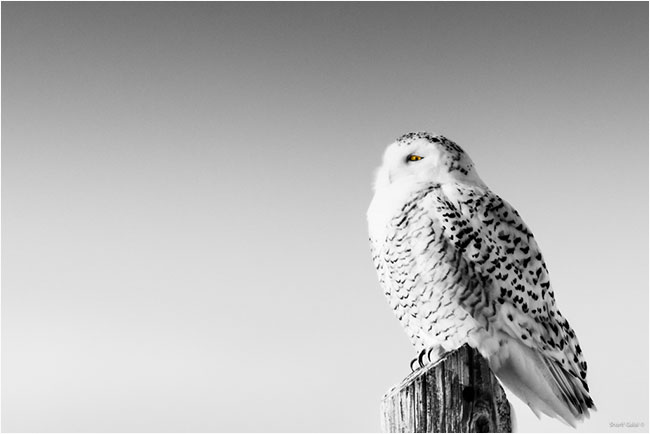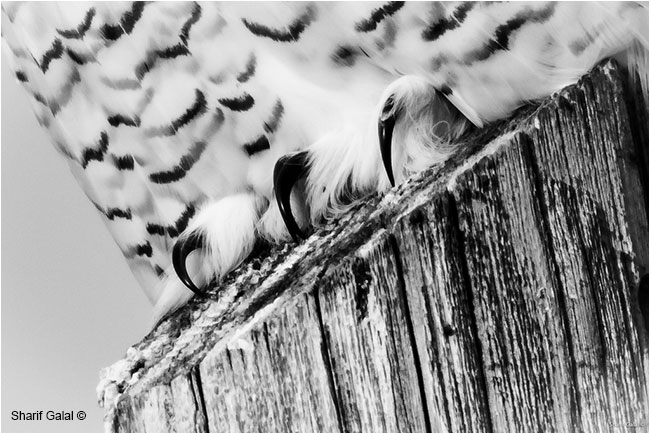
White Ghost of the Prairies seen by infrared (Part 3) Snowy Owls
by Dr.Sharif Galal
February 24, 2015
In winter, Snowy Owls migrate to the wind swept prairies that resemble the wide open spaces of the arctic tundra. These beautiful birds can be photographed east and south of Calgary between November and the end of March. For a reason that I don’t personally know, they tend to stay eastern of Calgary and I never seen anyone western to the city. For more information about snowys, please refer to White Ghosts of the Prairies Part 1& Part 2 by Dr. Robert Berdan.
Female snowy owl on power pole.
Telephone poles appear to be a favourite perch for Snowy Owls – males and females – where they can scan the fields for prey; they are also found frequently on fence posts and occasionally in trees.
Female snowy owl
Snowy owl in flight
Once you find a bird you need to get close without scaring them away. If they are on fence poles they seem to be more wary. Some owls seem to ignore my presence; others may take flight when I approach within 100 meters or sometimes more. Individual owls seem to vary in their wariness towards people, part of which is due to some of them could be juvenile and never been encountered with humans before so they might think human beings are predator trying to attack them, while some other adults know human beings and also knew that there is no risk of getting close to them.
Female snowy owl

Female snowy owl on fence post
Closeup of talons on a female snowy owl
In field, to identify males from females, males get whiter as they get older. Females are darker than males, with black spotting, and never become totally white. Some elderly males do become completely white, though many retain small flecks of dusky plumage .These magnificent owls sometimes remain year-round in their northern breeding grounds, but they are frequent migrants to southern Canada, the northern United States, Europe, and Asia.
If you are into owls like I am, Id highly recommend reading Dr Wayne Lynch`s book about Owls of the United States and Canada. In my opinion, this is the most comprehensive book integrating owl`s biology and behaviour in a very simple way. It is also full of illustration and magnificent photos.
Male Snowy Owl
Snowy owl in flight
Snowy owl in flight
In this series of photos, I was inspired by infrared wildlife photography and the work of Nick Brandt, and wanted to add a little bit of my touch on snowy owl photos. I tried to use a Hoya IR filter before but the results were disappointing as you will need a relatively long shutter speed to get the right exposure, which will never going to work especially when photographing birds as you always need a fast shutter speed to capture sharp photos. Instead, I used a software called nik silver effex pro to work on the zone system when converting files into black and whites. It is a very simple plugin to Photoshop and it has multiple presets inside where you can chose any of them based on your taste and you can tweak the effects after conversion to black and white, I then applied red digital filter to come up with this effect. In addition, I applied a history brush on the eyes to retrieve the yellow color at the end. In general, if you like this kind of effect, you have to expose for the highlights when shooting your subject and to bring the shadow details in Photoshop later. Digital cameras including smart phone ones have an incredible ability to keep details in shadow but not in highlight. If you get a blown out skies, nik silver effex pro will not be able to handle that.
I used a Nikon D7100 with Tamron 150-600mm and Pentax K3 mounted to Tamron 70-200mm f2.8 to capture these photos.
Dr. Sharif Galal is a medical doctor and a biotechnology researcher. He received his M.D. from Egypt and his specialty degree in diving medicine from Stellenbosch University- South Africa in addition to a Master’s degree in biomedical sciences from University of Calgary. Apart from medicine and research, Dr. Galal is an amateur underwater photographer, scuba diving instructor and an enthusiastic wildlife and nature advocate. He currently resides in Calgary, Alberta and can be contacted at:
www.facebook.com/sharifgalalphotography
Bibliography
- Dr Robert Berdan, article on snowy owls: www.canadiannaturephotographer. com/snowy_owls.html
- Wayne Lynch (2007). Owls of the United States and Canada. Johns Hopkins. ISBN 0-8018-9687-2
Other articles by Dr. Galal on the Canadian Nature Photographer
Dr. Sharif Galal - The Great Grey Owl
Dr. Sharif Galal - Rocky Mountain Marmot
Dr. Sharif Galal - The Great Salmon Run Adams River BC
Dr. Sharif Galal - Red Sea Coral Reefs
[ Top ]


.jpg)






